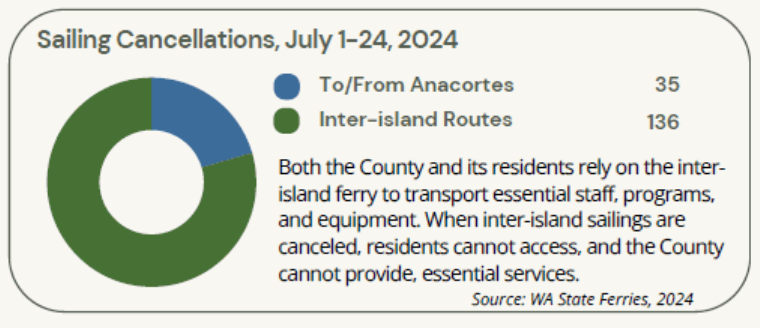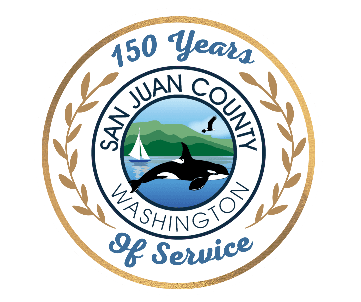WHEN THE ‘WHEELS CAME OFF’ THE FERRIES: 171 sailings canceled in 3-1/2 weeks in July

Wednesday, August 14, 2024
by Jeff Noedel
A two-page fact sheet prepared by San Juan County government for, among other constituents, the Governor of the the State of Washington, was released to the public yesterday. It can be seen here.
It’s an important and sobering read. The County Council instructed County employees to gather facts (quantitative and qualitative) about impacts to the islands community during excessive cancelations and chronic lateness in the WSF system in the San Juans.
This compilation didn’t touch on impacts to the vital tourism industry, the private construction industry, or quality-of-life impacts to citizens (and visitors). It didn’t delve into the frequency with which people with serious medical needs are missing appointments, or the extraordinary measures they are taking to keep those appointments, such as traveling to the mainland a day early and paying for a hotel room.
It just dealt with impacts observed by the County government’s staff.
The fact sheet observes impacts that haven’t received much attention, such as deep impacts on the San Juan County justice system, including impacts on trials, with jurors and witnesses unable to get to the courthouse, or to get home from Friday Harbor. It sheds light on the impacts to juvenile services, health services, election services, even the ability of assessors to get to properties. It even touches on the job performance and mental health impacts on County employees.
And the County fact sheet reveals two staggering statistics:
- In just 3-1/2 weeks in July (July 1 through 24), WSF canceled 171 sailings.
- Eighty percent of those cancelations were on the inter-island route.
WSF knows this is not good. And they wish the data looked better. In a recent Ferry Advisory Committee meeting witnessed by this reporter via a video call, a top WSF manager floated the idea of systematically undercounting canceled inter-island sailings by up to 75 percent, by ganging the multiple “legs” of the inter-island route together as just one canceled sailing.
In other words, for instance, a canceled sailing from Orcas Island to Shaw Island would be counted as 1/4 of a canceled sailing. Tell that to the Shaw resident with bags of frozen groceries stuck on the Orcas parking lot for an additional few hours! Your canceled trip across the water would be counted as 1/4 a canceled trip, by their official count.
The WSF manager’s idea drew a frosty response from some in the video meeting, but it was not explicitly ruled out in that meeting.
The two-page fact sheet was presented with the County’s request that the Governor, by executive order, help the County stand-up a larger passenger-only ferry service to move humans (not personal vehicles) between the islands over the next six months, and to run a small barge service to keep vital trucks moving between islands (delivery trucks, utility trucks, commercial trucks).
The private sector here is doing as much as it can to compensate for the high volume of cancelations and chronic lateness of WSF service here. But the gap between what the huge WSF vessels can transport and what a handful of small six-passenger motor boats and one-truck barges can do is not coming close to filling the gap.
And, we are told, “It took 20 years to create this problem, it will take 15 years to completely correct it.”
That message sells a little better on other routes, some enjoying 99 percent on time performance, according to WSF data. But WSF dysfunction is hitting the San Juans disproportionately. In a year when the legislature and Governor found $7 million to augment passenger-only ferry service for routes down-Sound, the San Juans got a study that is unlikely to produce any results for 1-1/2 years. And some peripheral WSF efforts that are producing minor results — minor, at least, compared to the level of canceled sailings.
The San Juan County Council is now asking for an amount equal to a small fraction of that $7 million to mitigate the damage and suffering here, now.
The County is arguing that the private sector response that has been in full swing for a year here is a study, a pilot program. And that the services of local operators can be rapidly amped-up with relatively little expense to the State government.







This discrimination is especially egregious given that, compared to the WSF 25% summer surcharge down-sound, the San Juan surcharge is 35%.
Great reporting. Do not let WSF skewer the cancellation numbers. Shameful that WSF would even try.